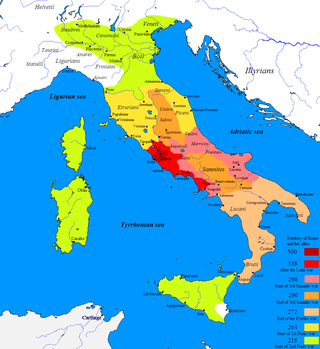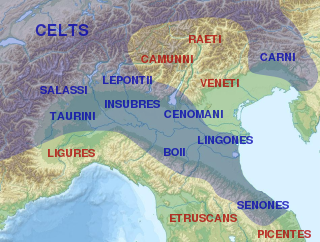Related Research Articles
Year 299 BC was a year of the pre-Julian Roman calendar. At the time it was known as the Year of the Consulship of Paetinus and Torquatus/Corvus. The denomination 299 BC for this year has been used since the early medieval period, when the Anno Domini calendar era became the prevalent method in Europe for naming years.

The First, Second, and Third Samnite Wars were fought between the Roman Republic and the Samnites, who lived on a stretch of the Apennine Mountains south of Rome and north of the Lucanian tribe.
Marcus Valerius Corvus, also sometimes known as Corvinus, was a military commander and politician who served in the early-to-middle period of the Roman Republic. During his career he was elected consul six times, beginning at the age of twenty-three. He was appointed dictator twice and led the armies of the Republic in the First Samnite War. He occupied the curule chair twenty-one times throughout his career. According to legend, he lived to the age of one hundred.

The Battle of Mount Gaurus, 343 BC, was the first battle of the First Samnite War and also the first battle fought between the Roman Republic and the Samnites. The battle is described by the Roman historian Livy as part of Book Seven of his history of Rome, Ab Urbe Condita Libri, where he narrates how the Roman consul Marcus Valerius Corvus won a hard-fought battle against the Samnites at Mount Gaurus, near Cumae, in Campania. Modern historians however believe that most, if not all, of the detail in Livy's description has been invented by him or his sources.

Lucius Papirius Cursor was a celebrated politician and general of the early Roman Republic, who was five times consul, three times magister equitum, and twice dictator. He was the most important Roman commander during the Second Samnite War, during which he received three triumphs.

The Battle of Vesuvius was the first recorded battle of the Latin War. The battle was fought near Mount Vesuvius in 340 BC between the Romans, with their allies the Samnites, against a coalition of several peoples: Latins, Campanians, Volsci, Sidicini, and Aurunci. The surviving sources on the battle, however, focus almost solely on the Romans and the Latins.

The (Second) Latin War of 340–338 BC was a conflict between the Roman Republic and its neighbors, the Latin peoples of ancient Italy. It ended in the dissolution of the Latin League and incorporation of its territory into the Roman sphere of influence, with the Latins gaining partial rights and varying levels of citizenship.

Titus Manlius Imperiosus Torquatus was a famous politician and general of the Roman Republic, of the old gens Manlia. He had an outstanding career, being consul three times, in 347, 344, and 340 BC, and dictator three times, in 353, 349, and 320 BC. He was one of the early heroes of the Republic, alongside Cincinnatus, Cornelius Cossus, Furius Camillus, and Valerius Corvus. As a young military tribune, he defeated a huge Gaul in one of the most famous duels of the Republic, which earned him the epithet Torquatus after the torc he took from the Gaul's body. He was also known for his moral virtues, and his severity became famous after he had his own son executed for disobeying orders in a battle. His life was seen as a model for his descendants, who tried to emulate his heroic deeds, even centuries after his death.

The Battle of Suessula was the third and last battle between the Samnites and the Roman Republic in 343 BC, the first year of the First Samnite War. According to the Augustan historian Livy, the Samnites gathered their army at Suessula, at the eastern edge of Campania. The Roman consul Marcus Valerius Corvus took his army by forced marches to Suessula. When the Samnites had to scatter their army to forage for food, Valerius seized the opportunity to capture the Samnite camp and then rout the Samnite foragers. Modern historians believe that details of the battle were entirely invented by Livy and his annalistic sources, and the battle's historicity has also been questioned.
The Roman–Etruscan Wars, also known as the Etruscan Wars or the Etruscan–Roman Wars, were a series of wars fought between ancient Rome and the Etruscans. Information about many of the wars is limited, particularly those in the early parts of Rome's history, and in large part is known from ancient texts alone. The conquest of Etruria was completed in 265–264 BC.
The Roman–Latin wars were a series of wars fought between ancient Rome and the Latins, from the earliest stages of the history of Rome until the final subjugation of the Latins to Rome in the aftermath of the Latin War.
The Roman–Volscian wars were a series of wars fought between the Roman Republic and the Volsci, an ancient Italic people. Volscian migration into southern Latium led to conflict with that region's old inhabitants, the Latins under leadership of Rome, the region's dominant city-state. By the late 5th century BC, the Volsci were increasingly on the defensive and by the end of the Samnite Wars had been incorporated into the Roman Republic. The ancient historians devoted considerable space to Volscian wars in their accounts of the early Roman Republic, but the historical accuracy of much of this material has been questioned by modern historians.
The Roman conquest of the Hernici, an ancient Italic people, took place during the 4th century BC. For most of the 5th century BC, the Roman Republic had been allied with the other Latin states and the Hernici to successfully fend off the Aequi and the Volsci. In the early 4th century BC, this alliance fell apart. A war fought between Rome and the Hernici in the years 366–358 BC ended in Roman victory and the submission of the Hernici. Rome also defeated a rebellion by some Hernician cities in 307–306 BC. The rebellious Hernici were incorporated directly into the Roman Republic, while those who had stayed loyal retained their autonomy and nominal independence. In the course of the following century, the Hernici became indistinguishable from their Latin and Roman neighbours and disappeared as a separate people.

Gnaeus Fulvius Maximus Centumalus was a military commander and politician from the middle period of the Roman Republic, who became consul in 298 BC. He fought in the final wars against the Etruscans and later led armies in the Third Samnite War. He was appointed dictator in 263 BC with responsibility for overseeing the start of the Roman ship building effort in the First Punic War.

The Battle of Saticula, 343 BC, was the second of three battles described by the Roman historian Livy, in Book Seven of his history of Rome, Ab Urbe Condita, as taking place in the first year of the First Samnite War. According to Livy's extensive description, the Roman commander, the consul Aulus Cornelius Cossus was marching from Saticula when he was almost trapped by a Samnite army in a mountain pass. His army was only saved because one of his military tribunes, Publius Decius Mus, led a small group of men to seize a hilltop, distracting the Samnites and allowing the consul to escape. During the night Decius and his men were themselves able to escape. The next day the reunited Romans attacked the Samnites and completely routed them. Several other ancient authors also mention Decius' heroic acts. Modern historians are however sceptical of the historical accuracy of Livy's account, and have in particular noted the similarities with how a military tribune is said to have saved Roman army in 258 BC during the First Punic War.

Over the course of nearly four centuries, the Roman Republic fought a series of wars against various Celtic tribes, whom they collectively described as Galli, or Gauls. Among the principal Gallic peoples described as antagonists by Greek and Roman writers were the Senones, Insubres, Boii, and Gaesatae.
The Roman-Aequian wars were a series of wars during the early expansion of ancient Rome in central Italy fought against the Aequi, an Italic tribe located to their east.
Gaius Sulpicius Peticus was a prominent 4th-century BC Roman politician and general who served as consul five times and as dictator once. Sulpicius was a member of the gens Sulpicia, a prominent patrician family which had attained the consular dignity a great number of times following the foundation of the republic. However, the familial relationship between Sulpicius and other known contemporary members of the gens is unknown, with the only information about his heritage being that his father was named Marcus and his grandfather was named Quintus.
Aulus Cornelius Cossus Arvina was a Roman statesman and general who served as both consul and Magister Equitum twice, and Dictator in 322 BC.
References
- ↑ Oakley(1998), p. 362
- ↑ Livy, vii.32.2-33.18, vii.37.4-17
- ↑ Livy, vii.38.4; D.H. xv.3.2; App. Samn. 1
- ↑ D.H. xv.3.2-3
- ↑ Livy, vii.38.5; D.H. xv.3.4-9; App. Samn. 1
- ↑ Livy, vii.38.8; D.H. xv.3.10
- ↑ Livy, vii.38.9-10; D.H. xv.3.10-11
- ↑ Livy, vii.39.1-2; D.H. xv.3.12; App. Samn. 1
- ↑ Livy, vii.39.3-6; D.H. xv.3.13; App. Samn. 1
- ↑ Livy, vii.39.7; D.H. xv.3.14-15; App. Samn. 1
- ↑ D.H. xv.3.15; App. Samn. 1
- ↑ Livy, vii.39.8; App. Samn. 1
- ↑ Livy, vii.39.8-17
- ↑ Livy, vii.40.1-19
- ↑ Livy, vii.41.1-2
- ↑ Oakley(1998), p. 362
- ↑ App. Samn. 2
- ↑ Livy, vii.42.3-7
- ↑ Oakley(1998), p. 363
- ↑ Oakley(1998), p. 363
- ↑ Forsythe(2005), p. 273
- ↑ Forsythe(2005), p. 273
- ↑ Oakley(1998), p. 363, Forsythe(2005), p. 273
- ↑ Oakley(1998), p. 363
- ↑ Oakley(1998), p. 363
- ↑ Forsythe(2005), p. 273
- ↑ Oakley(1998), p. 363
- ↑ Oakley(1998), pp. 363-364
- ↑ Forsythe(2005), p. 272
- ↑ Livy, vii.41.3-8
- ↑ Livy, vii.42.1-2
- ↑ Livy, vii.42.2
- ↑ Forsythe(2005), p. 274
- ↑ Oakley(1998), p. 383
- ↑ Henry George Liddell (1855) A History of Rome, p.182
- ↑ Oakley(1998), p. 384
- ↑ Forsythe(2005), p. 275
- ↑ Oakley(1998), p. 384
- ↑ Forsythe(2005), p. 275